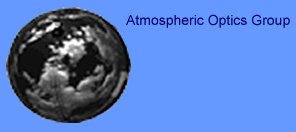
 |
| |
|
|
|
|
|
|
|
|
|
Overview of Current WorkThe
late 1990’s and early 2000’s have been spent on developing
Whole Sky Imagers and their capabilities in several areas A new Daytime
WSI was developed for Germany's weather service, Deutsche Wetterdienst.
This instrument provides much higher image quality than the original Day
WSI’s, extends the sensitivity into the NIR, and includes calibrated
radiances. The instrument includes additional spectral bands, as well
as two polarizers in the filter changer. It includes a 12 bit digital
camera, as well as a fisheye lens and solar/lunar occultor.
A new miniaturized version of the imager has been developed for downward looking applications from a UAV. Two of these instruments have been developed for Sandia National Labs, and the ARM UAV program. One will sense wavelengths near 650 nm in the red, and the other will sense wavelengths near 1600 nm in the NIR. Both will be calibrated to provide the absolute radiance distribution of the lower hemisphere below the aircraft. Analysis work during this period has included development of a new night-time cloud algorithm based on the detection of stars. Two versions of this algorithm are in operation; one developed from MPL’s ideas by our ARM sponsors, is being used on the ARM archival data, as noted earlier. A second version developed at MPL is being used to provide the real time algorithm results with military instruments. This version of the algorithm is also under further development, with the goal of extracting the spatial distribution of the atmospheric beam transmittance at night. Additional work has included analysis of Cloud Free Line of Site statistics from the Day WSI database, as well as the persistence of these parameters. Additional engineering work currently includes the development of the Field Calibration Device, which includes programs to enable less experienced personnel to interactively acquire the calibration data and interactively process the data. A new solar occultor which will mask much smaller portions of the sky is under development. As always, analysis of new techniques for meeting the needs of the atmospheric research community are under way.
Produced
by the Marine Physical Laboratory, SIO.
|